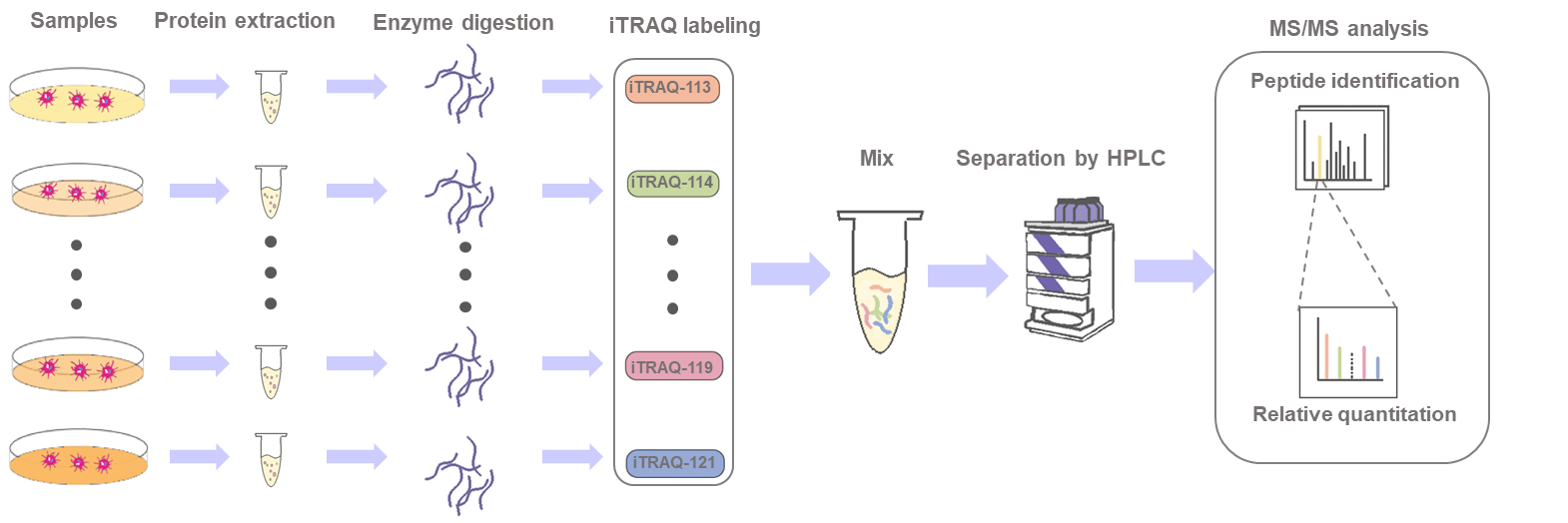Viral iTRAQ Proteomic Service
Isobaric tags for relative and absolute quantification (iTRAQ) is a multiplex protein labeling technique for protein quantification in complex mixtures based on tandem mass spectrometry (MS/MS). Using isobaric tags (8-plex and 4-plex), the technique identifies specific amino acid sites of a peptide and then performs MS/MS. Relative and absolute protein content in 4 or 8 different samples can easily and quickly be compared using iTRAQ technology. The technique can be applied to analyze quantitative changes in highly multiplexing samples. Notably, the iTRAQ-based proteomic method is efficient to detect the localization of viral proteins.
How does iTRAQ technology work?
Compared with conventional proteomics methods, iTRAQ combined with liquid chromatography-tandem mass spectrometry (LC-MS/MS) is more accurate and sensitive. The quantitative proteomics technique of iTRAQ has emerged as an effective method for proteomics quantification, especially for determining low-abundance protein quantification in samples. iTRAQ is a quantitative approach for labeling the primary amines of peptides and proteins based on multiplexed isobaric reagents. The isobaric reagents are usually comprised of a mass balance group, an N-methyl piperazine reporter group, and an N-hydroxy succinimide ester group (a peptide reactive group). The mass of the balance group and the reporter group is 28 ~ 31 Da and 114.1 ~ 117.1 Da, respectively, and the mass sum of the two remains constant. Therefore, the labeled peptides from different samples exhibit identical mass and chromatographic properties. The quantification is facilitated through quantitative analysis of reporter groups remaining during collision-induced dissociation (CID) and subsequent MS/MS. Through further software processing, the relative and absolute quantitative information of proteins can be obtained.
Advantages of iTRAQ-based proteomic method
- Able to label up to 8 samples in a single experiment. The operation is simple and fast to reduce systematic error in multiple mass spectrometry detection.
- Allow to investigate peptides and compare multiple conditions simultaneously, experimental design is more flexible.
- Suitable for a variety of protein samples, and for determining low-abundance protein quantification in samples.
- Good reproducibility, high sensitivity, qualitative and quantitative can be carried out simultaneously.
iTRAQ-based proteomic method to viral infection
In recent years, the iTRAQ-based quantitative proteomics method has been employed to study virus-host interactions. This technique can be used to investigate the proteins that are associated with host response and provide insight into the complexity of viral infection. For instance, the iTRAQ-based quantitative proteomics method has been applied to HIV-1 pathology, searching for potential drug targets as well as new biomarkers. In addition, this chemically labeled proteomic platform allows researchers to compare paired samples before and after infection.
Our technology platform
Triple TOF 5600, Q-Exactive, Orbitrap Fusion™ Tribrid™
The workflow of our services

iTRAQ coupled with MS/MS is one of the most advanced technologies in modern quantitative proteomics, allowing for the comparison of the relative amount of proteins from normal and diseased samples in a single experiment. Creative Proteomics is a forward-looking research institute as well as a leading custom service provider in the field of viral proteomics. We provide custom experimental design and detailed research reports according to customers' specific project needs. Here, we can perform an iTRAQ protein quantification service to help to identify the host response to virus invasion and reveal the pathogenesis of virus infection.
Simply let us know about your research needs and we will respond rapidly to your inquiry. Contact us right now!
Reference
- Grabowska, K., et al. (2020). "HIV and Proteomics: What we have learned from high throughput studies." PROTEOMICS–Clinical Applications, 2000040.
* For research use only.

